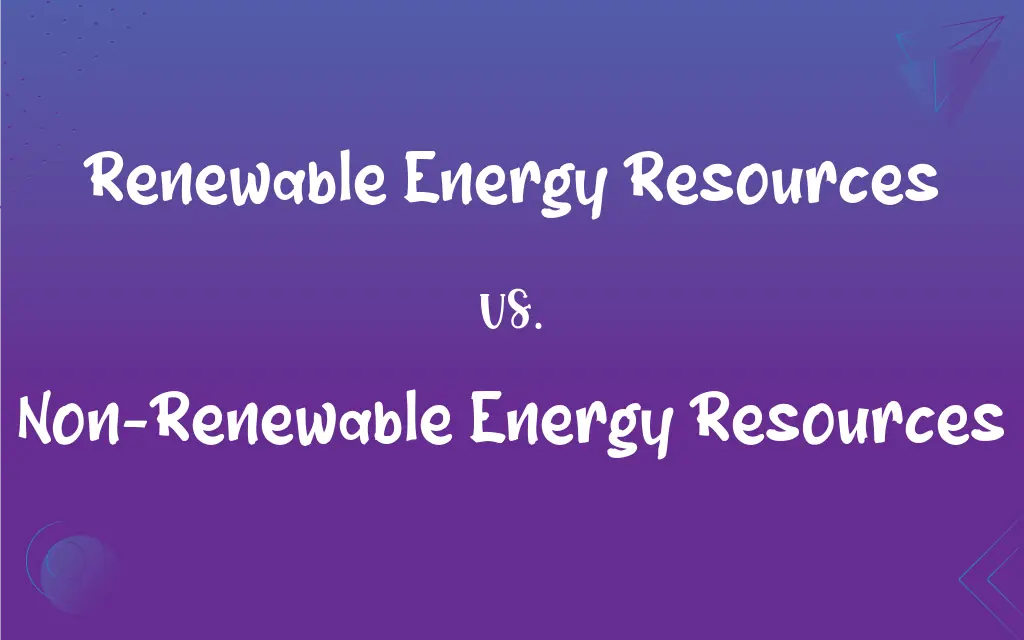Renewable Energy Resources vs. Non-Renewable Energy Resources: What's the Difference?
Edited by Aimie Carlson || By Harlon Moss || Updated on October 17, 2023
Renewable energy resources are naturally replenishing; non-renewable energy resources are finite and deplete over time.

Key Differences
Renewable energy resources are characterized by their ability to regenerate naturally within a human timeframe. In contrast, non-renewable energy resources, once used, diminish and can't be replenished in the same span.
Harnessing renewable energy resources usually has a lower environmental impact, drawing from sources like the sun or wind. However, non-renewable energy resources, derived mainly from fossils, often result in significant environmental consequences.
While renewable energy resources can technically last indefinitely given proper management, non-renewable energy resources have a clear expiration, signaling the need for alternatives in the future.
Regions globally are investing in renewable energy resources due to sustainability and environmental concerns. Simultaneously, non-renewable energy resources, though currently dominant, face challenges regarding their long-term viability.
Diversifying energy portfolios with renewable energy resources is seen as crucial for energy security. Still, the current infrastructure heavily relies on non-renewable energy resources, which offer consistent and large-scale energy output.
ADVERTISEMENT
Comparison Chart
Regeneration
Naturally replenishes in a short timeframe
Finite and depletes with use
Primary Sources
Sun, wind, hydro, geothermal, biomass
Coal, oil, natural gas, uranium
Environmental Impact
Typically lower
Often higher due to emissions and extraction
Longevity
Can last indefinitely with proper management
Have a finite duration and will eventually run out
Current Global Focus
Rising due to sustainability concerns
Still dominant but facing future challenges
ADVERTISEMENT
Renewable Energy Resources and Non-Renewable Energy Resources Definitions
Renewable Energy Resources
Energy that won't run out with sustained use.
Hydropower relies on flowing water, making it a sustainable choice among renewable energy resources.
Non-Renewable Energy Resources
Finite energy sources that deplete over time.
Coal mines, gradually emptying, symbolize the limits of non-renewable energy resources.
Renewable Energy Resources
Eco-friendly power derived from the environment.
Harnessing wind through turbines showcases the potential of renewable energy resources.
Non-Renewable Energy Resources
Currently dominant but facing sustainability challenges.
Despite their consistent energy output, the depleting reserves spotlight the challenges of non-renewable energy resources.
Renewable Energy Resources
Alternatives to traditional fossil fuels with continuous replenishment.
Biomass energy, derived from organic materials, represents the diversity of renewable energy resources.
Non-Renewable Energy Resources
Power sources with higher greenhouse gas emissions.
The burning of natural gas, while cleaner than coal, still contributes to the emissions from non-renewable energy resources.
Renewable Energy Resources
Power solutions with a lesser carbon footprint.
Geothermal energy, tapping into the Earth's heat, is a clean representative of renewable energy resources.
Non-Renewable Energy Resources
Energy forms that won't regenerate in foreseeable human timelines.
Uranium, used in nuclear power plants, is a limited resource among non-renewable energy resources.
Renewable Energy Resources
Sources that naturally regenerate within human lifetimes.
Solar panels capture energy from the sun, a prime example of renewable energy resources.
Non-Renewable Energy Resources
Energy derived primarily from ancient organic remains.
Oil, formed from ancient marine life, is a key component of non-renewable energy resources.
FAQs
What's the primary distinction between renewable and non-renewable energy resources?
Renewable energy resources naturally regenerate quickly; non-renewable ones are finite and exhaust over time.
How long will non-renewable energy resources last?
It's variable, but many estimates suggest several decades to a century for major resources like oil and coal.
Why is coal considered a non-renewable resource?
Coal formation takes millions of years, making its rate of consumption unsustainable.
Are renewable energy resources always environmentally friendly?
While generally more eco-friendly, some renewables, like biomass, may still have environmental impacts.
Why is there a push towards renewable energy resources?
Concerns about environmental impact, sustainability, and energy security drive the shift.
What's a leading example of renewable energy resources?
Solar energy, captured using panels, is a prominent example.
Are non-renewable energy resources more reliable?
Currently, they often offer more consistent large-scale energy, but renewables are advancing rapidly.
Can renewable energy resources meet global demand?
With advancements and proper infrastructure, they have the potential to meet or surpass global energy needs.
Are hydropower and geothermal power renewable?
Yes, both harness naturally recurring processes for energy.
How do renewable energy resources affect climate change?
By reducing greenhouse gas emissions, they help mitigate the effects of climate change.
Are batteries a form of renewable energy?
No, but they can store energy from renewable sources for later use.
Why are non-renewable energy resources called "fossil fuels"?
They originate from ancient organic material, making them "fossils" in an energy context.
Can we completely replace non-renewable energy resources with renewables?
Technologically, it's possible, but it requires infrastructure, investment, and policy changes.
How do renewable energy resources impact the economy?
They can create jobs, drive innovation, and potentially reduce energy costs in the long run.
Are nuclear energy sources renewable or non-renewable?
They're non-renewable; uranium, the primary fuel, is finite.
How do countries store energy from renewable sources?
Methods include batteries, pumped storage, and thermal storage.
What challenges do non-renewable energy resources pose?
They lead to environmental issues, have a finite existence, and can pose geopolitical challenges.
Which non-renewable energy resource is the cleanest?
Natural gas emits fewer pollutants than coal or oil but still has environmental impacts.
Is the shift to renewable energy resources cost-effective?
While initial costs can be high, long-term benefits like reduced operational costs can make it cost-effective.
What's the future of non-renewable energy resources?
They'll likely continue to play a role but face reduction due to depletion and environmental concerns.
About Author
Written by
Harlon MossHarlon is a seasoned quality moderator and accomplished content writer for Difference Wiki. An alumnus of the prestigious University of California, he earned his degree in Computer Science. Leveraging his academic background, Harlon brings a meticulous and informed perspective to his work, ensuring content accuracy and excellence.
Edited by
Aimie CarlsonAimie Carlson, holding a master's degree in English literature, is a fervent English language enthusiast. She lends her writing talents to Difference Wiki, a prominent website that specializes in comparisons, offering readers insightful analyses that both captivate and inform.
































































